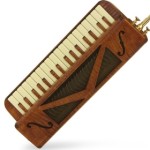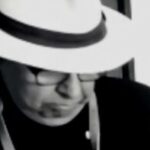Studies in Melodica Articulations
Tagged: Melodica Articulation Studies
- This topic has 22 replies, 8 voices, and was last updated 6 years, 3 months ago by
Helen R.
-
AuthorPosts
-
August 4, 2015 at 2:08 pm #5732
 LowboyParticipant
LowboyParticipantHello Melodicans:
Several month ago, I made a series of studies in melodica articulation and talked to you about some of the effects. I finally got around to listening and editing a few of these recordings.
These recordings are several months old and do not reflect the advancements I have made since that time. The recordings certainly do not reflect my current distorted blues harmonica sound. These “studies” were recorded by sticking a Yamaha PR7 stereo pocket microphone in the room and playing my Hohner Piano 26/27 melodicas through a delay pedal and into my studio monitoring system (a very clean sound system). Any distortion you hear is from articulation I do believe. I don’t think I used any other pedals; no EQ; just playing into a mic into my studio monitors and recording the sound using the pocket recorder. I possibly used my good stereo Audio Technica mic. I really do not remember.
Then I had to convert the files from Wav to MP3 because I used Garage Band to edit them. So the recordings are far from studio quality, but they are good enough to hear the effects produced by my articulations. The playing represents “study” playing/improvisation.
Rough descriptions of studies:
Track 1–Example of super clean flute sound and distorted sound from the same melodica
Track 2–Bending and otherwise changing high notes, distorion, chords
Track 3–Self distortion, singing into melodica, Leslie imitation
Track 5–Study in chord articulations and Leslie effects
Track 8–Improvisation with groove, distortion from several techniques: humming into melodica, blowing hard, and compressing reeds by holding instrument against chest[audio src="https://dl.dropboxusercontent.com/u/6237809/Track%201%20Melodica%20Articulations.mp3" /]
[audio src="https://dl.dropboxusercontent.com/u/6237809/Track%202%20Melodica%20Articulations.mp3" /]
[audio src="https://dl.dropboxusercontent.com/u/6237809/Track%203%20Melodica%20Articulations.mp3" /]
[audio src="https://dl.dropboxusercontent.com/u/6237809/Track%205%20Melodica%20Articulations.mp3" /]
[audio src="https://dl.dropboxusercontent.com/u/6237809/Track%208%20Melodica%20Articulations.mp3" /]I welcome comments from every perspective.
Regards,
Lowboy
August 5, 2015 at 9:33 am #5735 QuetscherParticipant
QuetscherParticipantCongratulations, Lowboy, these are fantastic studies!
First of all I wonder how you managed to make the melodica sound so dark without EQ’s; is there a trick? Did you hold it against your chest while playing? Or was it the mic position?
I have tried to imitate some of your articulations and realized that it takes a large amount of skills even to get near your results. I like your bendings and your WahWah’s which actually sound harp-like (meaning that they sound like someone blew into the instrument forming a certain vowel and then changing vowels while playing). I also love your chord studies and your distortions although I don’t understand if there’s any difference between the distortion on Track 2 and what you call “self distortion” on Track 3. Anyway, they both sound great.
In my opinion singing into the melodica is a topic for endless studies because you get so many different results depending on what you’re doing (singing in unison, humming a certain note all the time, singing slightly out of tune compard to what you play…).
The keyboard noise is very interesting for emphasizing the rhythm, it’s funny to hear the difference between certain instruments (your melodicas sound like “clank” whereas the Vibrandoneon sounds like “clock”…).
Thanks for sharing!
August 5, 2015 at 11:02 am #5738 LowboyParticipant
LowboyParticipantThanks Quetscher. Lots of work went in to getting this far.
I think the dark sound comes from three main elements:
(1) The melodica itself; the Hohner Piano 26/27/32s are dark sounding to begin with if for no other reason than the sound holes project downward. If you play one upside down, it sounds similar to other melodicas, but does have the slightly darker vintage Hohner sound.
(2) The Lone Wolf Blues Company Harp Delay pedal; it is a must have for the blues. Not only does it round off the top end to remove harsh frequencies (making it sound darker), but as the frequency of a note changes during its duration, the echoes capture the original frequencies and the changes in frequency and mixes them together. I never play without the Harp Delay pedal.
(3) No doubt the biggest change in timbre comes from holding the sound holes against my chest. I can achieve complete muffling of the sound and choking of the reeds by holding the back of the melodica against my chest. The pressure and angle of the hold, all the way to a complete release provides an incredible range of timbres, including dark, dark, dark.I will review my recordings and answer your other questions in a separate post.
Regards,
Lowboy
August 5, 2015 at 6:48 pm #5744 LowboyParticipant
LowboyParticipantTo address your comments/questions Quetscher–When playing the blues, I do not worry about key click too much. I welcome key click as part of the sound (to dirty it up and add the percussive effect as you mentioned). If I don’t want the key click when playing a soft or smooth passage, I just hit the keys softer to remove the key click. Actually, it kind of happens organically: one tends to play aggressive passages hard, adding key click. One tends to play sweet passages softly and gently without adding key click. Sometimes I just bang on the keys without blowing into the melodica to add percussive effects to the music. The only time key click does not sound good to me is when excessive high frequency EQ is added to the signal chain, something I normally do not do. For music other than blues, I tend to minimize the key click through my playing technique.
I agree, singing and humming into a melodica provides a wide range of effects depending how you do it. I learned about the possibilities a year ago, and have toyed with it since then. But it is very difficult to do, and there is much to explore, so I only work on it a bit at a time. It will definitely be a technique that I add to my arsenal for special effect.
My descriptions of the tracks were not very clear. In terms of distortion, I think it can be achieved several ways based on my experience with the Hohner Piano 26/27s. (Other melodicas may NOT respond the same way.) With a Hohner piano 26/27 (HM-26, HM-27) you may be able to get distortion by:
1. Cranking up a tube amp
2. Using distortion pedals
3. Playing hard
4. Playing chords (all the harmonics from multiple notes mixing together in the body of the melodica offers a distortion)
5. Playing dissonant intervals or dissonant chords (accentuates the harmonic distortions as noted in item 4)
6. Pressuring the sound chamber by holding the Hohner Piano 26/27 tightly against your chest while playing
7. Getting other reeds to respond in sympathy with the note you are playing by pressing most of the melodica against your chest, but leaving some of the sound holes exposed (too complicated to explain here in detail, and still under investigation).
8. Humming and singing into the melodica as you play notesSo rather than try to explain my poorly worded descriptions of the tracks, I would say that any distortion you hear was created by one of the above techniques.
Regards,
Lowboy
August 5, 2015 at 6:56 pm #5745 LowboyParticipant
LowboyParticipant“Pressurizing the sound chamber … “
August 5, 2015 at 7:05 pm #5746 LowboyParticipant
LowboyParticipantForgot two other ways to get distortion:
9. By over driving the microphone diaphragm with a high sound pressure level or by physical compression a la harp player with a fully cupped harp
10. By over driving a digital effects processor with an input signal that is too hitLowboy
August 5, 2015 at 7:16 pm #5747 LowboyParticipant
LowboyParticipantOh, and the dark sound of the chords on Track 5 comes from modifying my Hohner Piano 27 (HM-27) with a baffle. Lowboy
August 5, 2015 at 11:53 pm #5757August 5, 2015 at 11:58 pm #5759 DarenKeymaster
DarenKeymasterHow I made the links above
1) I typed the following: Audio link 1
2) I highlighted the whole phrase: ‘Audio link 1’
3) I pressed the link button above the text box
4) I typed the link address in the first box (starting with https, and ending with mp3)
5) I left the second box empty, and pressed the ‘add link’ button
It seems this is the only way of getting audio links to work here!
August 6, 2015 at 12:01 am #5760 DarenKeymaster
DarenKeymasterSome really great sounds you’re getting here Lowboy. I particularly some of the singing and playing on the third link, but its all very interesting and creative. Would be great to hear it all in one track!
August 6, 2015 at 2:41 am #5768 LowboyParticipant
LowboyParticipantNext time I will make it one track. Don’t know what I was thinking. Lowboy
August 6, 2015 at 4:01 am #5769 Melodica-MeParticipant
Melodica-MeParticipantLowboy, very inspiring, you know I am not a blues man but I am definitely getting the itch.
Keep them coming.
Melodica-MeAugust 6, 2015 at 11:49 am #5770 LowboyParticipant
LowboyParticipantQuetscher,
I forgot to mention that microphone proximity effect is huge in changing the tonal characteristics of the melodica without using EQ.
As you may know, as you crowd a mic (get really close to it), the bass response increases dramatically. Not only do I crowd the mic a lot to add low end, but sometimes I squish the mic (with a big fluffy windscreen on it) between the back of my melodica and my body. This offers the same effect as a harp player cupping his harmonica and mic to create an air tight seal. Huge bass response results. It makes the instrument sound twice as large as it is. And if I (or a harp player) blows hard, there is a compression/overdrive effect on the sound/mic and a nice distortion results.
Lowboy
August 6, 2015 at 1:14 pm #5771 QuetscherParticipant
QuetscherParticipantLowboy, thanks for your explanations. I hope I fully understand everything – it will take quite a lot of time to try out all the things you explained to get that dark sound without EQing but it’ll be worth it…
August 6, 2015 at 9:24 pm #5772 LowboyParticipant
LowboyParticipantHi Quetscher,
I will still use EQ when and where appropriate, but I don’t think I used any during the recording of those studies. I wish I had taken notes during the recording several months ago as I am having a hard time remembering the exact setup. But I do remember my general approach was to use minimum processing (delay pedal, and maybe very mild compression), a clean sound system, and so I could explore technique only as a means to achieve a wide range of sounds/noises/timbre.
So in practice, I would say I will use EQ for effect and to fit the space I am playing in. For example, the blues melodica/guitar track was recorded outside with my blues setup that includes the Vox AC10 guitar amp, which has bass and treble tone controls that I change considerably based on the song and the melodica I am playing.
I guess my advice would be, by all means, use EQ. But use it only after you tried other means (melodica selection, amp selection, microphone selection, effects selection, and playing technique) to achieve the sound you want.
Regards,
Lowboy
-
AuthorPosts
- You must be logged in to reply to this topic.
